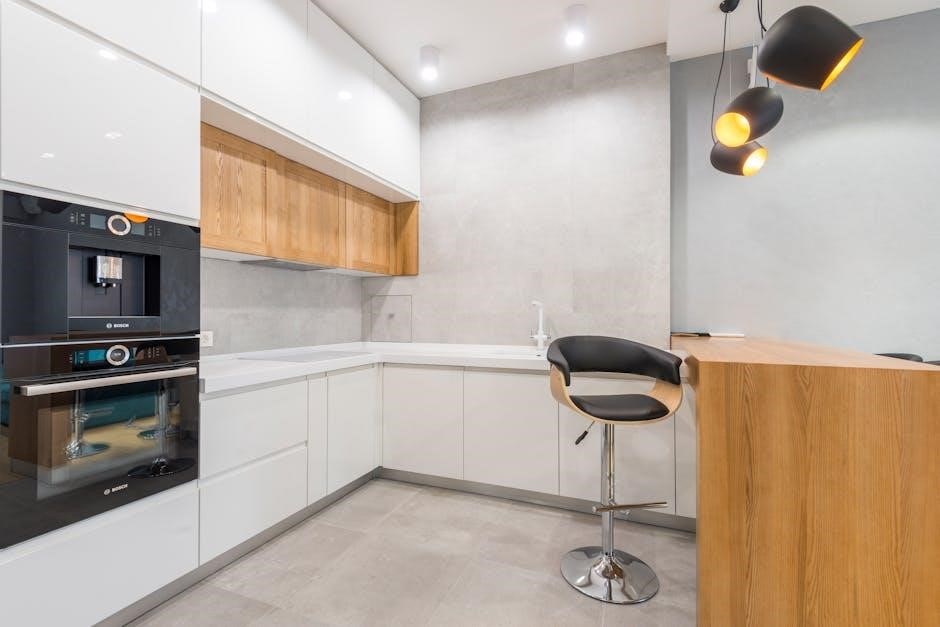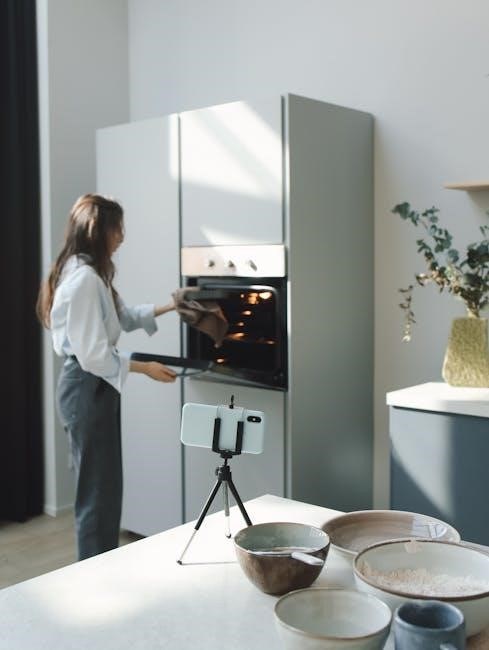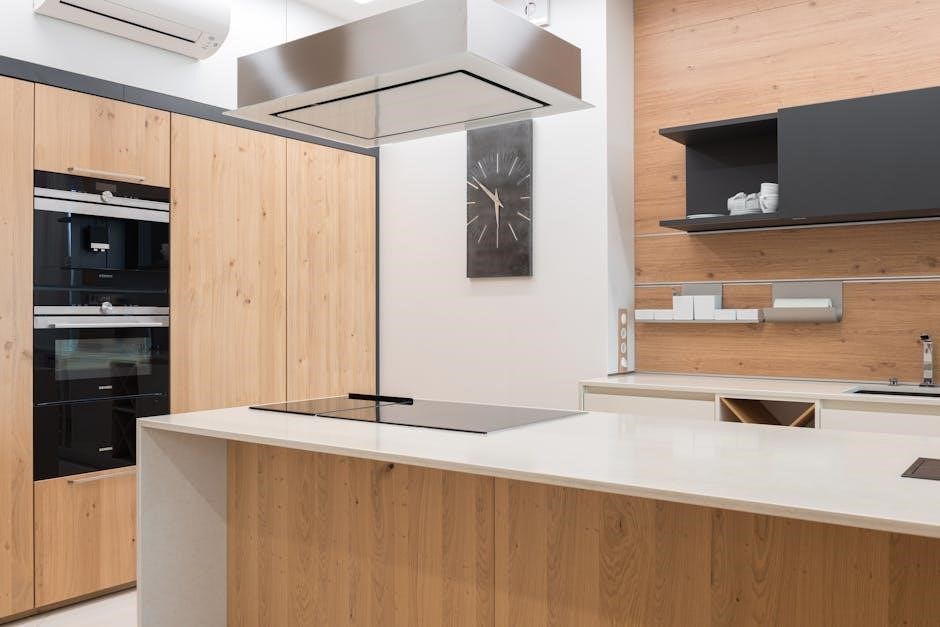Discover how to effectively use the self-cleaning feature on your GE double oven. This guide provides step-by-step instructions for safe and efficient oven maintenance, ensuring optimal performance and cleanliness.

What is the Self-Clean Feature?
The self-clean feature on your GE double oven is a built-in cleaning system designed to simplify oven maintenance. It uses high temperatures to burn food residue and spills into ash, which can then be easily wiped away. This feature eliminates the need for harsh chemicals, making the process safer and more environmentally friendly. The self-clean cycle is ideal for tackling tough stains and grime buildup over time. While it’s highly effective, it’s important to note that heavily soiled ovens may still require some manual cleaning before or after the cycle. This feature is a convenient and efficient way to keep your oven looking like new.
Benefits of Using the Self-Clean Cycle
The self-clean cycle offers numerous benefits, making it a convenient and efficient way to maintain your GE double oven. It eliminates the need for harsh chemicals, reducing exposure to toxic fumes and making the process safer for both people and the environment. The high-heat cleaning burns food residue into ash, which is easy to wipe away, saving time and effort. Regular use of the self-clean cycle helps maintain your oven’s performance and appearance, preventing grime buildup and ensuring optimal cooking results. Additionally, it reduces the need for frequent manual cleaning, making oven maintenance a hassle-free experience. This feature is a time-saving solution for homeowners.

Preparation for Self-Cleaning
Preparation for self-cleaning involves disconnecting power, removing racks, and protecting surrounding surfaces. Clear the area and ensure the oven is cool. Follow safety guidelines for a smooth process.
Removing Oven Racks and Accessories
Removing oven racks and accessories is essential before starting the self-clean cycle. Take out all racks, shelves, and utensils, as high temperatures can damage them. For GE double ovens, ensure no cookware or aluminum foil remains inside, as these can melt or warp. Wash racks separately with soap and water, or soak them for easier cleaning. Leaving racks in during self-cleaning can cause discoloration or damage. Always refer to your GE oven manual for specific instructions on removable parts. This step ensures a safe and effective cleaning process without risking harm to your oven or its components.
Cleaning Heavy Soil Before the Cycle
Cleaning heavy soil before the self-clean cycle is crucial for optimal results. Large food particles can interfere with the cleaning process, so remove them using a gentle cleanser or soft brush. Avoid harsh chemicals, as they may damage the oven surfaces. For tough stains, mix baking soda and water to create a paste, apply it to the affected areas, and let it sit overnight. This helps loosen grime, making the self-clean cycle more effective. Ensure the oven is cool before pre-cleaning to avoid burns. For severe soil buildup, set the oven to its highest temperature for 30 minutes to 1 hour to soften residue. This step ensures a more efficient self-cleaning process and prevents residue from hardening further.
Protecting Surrounding Surfaces
Protecting surrounding surfaces is essential before starting the self-clean cycle to prevent damage from high temperatures and cleaning residue. Cover nearby countertops, walls, and floors with heat-resistant mats or drop cloths to shield them from splatters and debris. Open windows and ensure good ventilation to reduce strong fumes. Keep children and pets away to avoid accidents. Use specific heat-resistant covers designed for ovens if available. Check manufacturer recommendations for protecting different materials and apply coverings before starting the cycle. Remove coverings only after the oven cools down to prevent damage. Maintain surfaces by cleaning any residue post-cycle for optimal condition. Research and invest in effective protective products that balance quality and affordability. Follow these steps to ensure surfaces remain undamaged and maintain their appearance.

Operating the Self-Clean Cycle
Operating the self-clean cycle involves initiating the process, monitoring progress, and adhering to safety guidelines to ensure effective cleaning while maintaining appliance efficiency and safety standards.
Starting the Self-Clean Process
Starting the self-clean process on your GE double oven involves pressing and holding the self-clean button until the display shows the clean mode. Ensure the oven is empty, racks are removed, and the oven door is closed. Select the desired cleaning cycle for the upper, lower, or both ovens using the control panel. Choose the recommended duration based on soil level—typically 2-4 hours. Once set, the oven will automatically lock, and the cleaning cycle will begin. A clicking sound may be heard as the oven activates. Keep the kitchen well-ventilated, as fumes may be released during the process.
Setting the Cleaning Duration
Setting the cleaning duration on your GE double oven is straightforward. Use the control panel to select the desired cleaning time based on the level of soil inside the oven. Light soil typically requires 2 hours, medium soil 3 hours, and heavy soil 4 hours. The oven will automatically adjust the temperature and cycle duration. Once the duration is set, the oven will lock, and the cycle will begin. Ensure the oven is empty and racks are removed before setting the duration. The oven will remain locked until it cools down after the cycle completes. Proper duration selection ensures effective cleaning without excessive energy use.
Understanding the Cleaning Process
Understanding the self-cleaning process of your GE double oven is essential for effective maintenance. The self-clean feature uses high temperatures, typically around 900°F, to convert food residue and spills into ash. This process eliminates the need for harsh chemicals, making cleaning safer and more convenient. Once the cycle starts, the oven locks to ensure safety. The intense heat breaks down tough grime, and after the cycle completes, the oven cools, allowing you to wipe away the ash easily. This method is energy-efficient and maintains your oven’s performance by removing grease and food particles that could affect heating consistency. Regular use of this feature keeps your oven in optimal condition and ensures longevity.

Safety Precautions During Self-Cleaning
Adhere to safety guidelines to ensure a secure self-cleaning process. Maintain proper ventilation to prevent fume buildup. Avoid exposure to harmful emissions. Keep children and pets away during the cycle.
Ensuring Proper Ventilation
Proper ventilation is crucial during the self-cleaning cycle to prevent harmful fumes from accumulating. Open windows and doors to allow fresh air to circulate. Use your kitchen exhaust fan to help remove fumes. Ensure the oven vent is unobstructed to maximize airflow. Avoid inhaling the fumes, as they can be hazardous. Keep the kitchen well-ventilated throughout the cycle. This step is essential for safety and ensures the cleaning process is effective without exposing household members to harmful emissions. Always prioritize ventilation to maintain a safe environment during the self-cleaning process.
Avoiding Harmful Fumes
Avoiding harmful fumes during the self-cleaning cycle is essential for safety; The high heat breaks down food residue into ash, releasing strong fumes that can be hazardous if inhaled. Always ensure proper ventilation and avoid staying in the kitchen during the cycle. Keep pets and children away, as they may be more sensitive to the fumes. Do not use the oven during self-cleaning, as fumes can be toxic. If you notice strong odors, increase ventilation by opening more windows. These precautions help minimize exposure and ensure a safer cleaning process. Remember, fumes are a natural part of self-cleaning but can be managed with proper care.

Keeping Children and Pets Away
Keeping children and pets away during the self-cleaning cycle is crucial for their safety. The oven reaches extremely high temperatures, and the fumes released can be harmful. Children may not understand the dangers, so supervision is essential. Pets, especially, may become anxious or curious, so it’s best to secure them in another room. Use baby gates or locks to prevent accidental access to the kitchen. Ensure all family members know to stay away until the cycle completes and the oven cools down. This precaution minimizes risks of burns or exposure to harmful fumes, ensuring a safer environment for everyone in the household.

Post-Cleaning Care
Post-cleaning care ensures your GE double oven remains in excellent condition. Allow the oven to cool, wipe down surfaces, and dispose of residue properly for optimal maintenance and safety.
Allowing the Oven to Cool
After the self-clean cycle, allow your GE double oven to cool completely. This process may take several hours, as the oven remains extremely hot. Keep the oven door closed during cooling to retain heat and ensure even temperature reduction. Avoid touching the oven surfaces, as they can cause burns. Letting the oven cool prevents damage to the interior and ensures the self-clean process is effective. Once cooled, wipe down surfaces gently to remove any residue. Proper cooling also helps maintain the oven’s performance and longevity, ensuring it’s ready for the next use. Always prioritize safety and patience during this step.
Wiping Down the Oven Interior

After the self-clean cycle, once the oven has cooled, use a damp cloth or sponge to wipe down the interior. This step removes any remaining residue or ash. For stubborn spots, a gentle cleanser can be applied, but avoid harsh chemicals. Use a soft, non-abrasive scrubber to prevent scratching the surfaces. Pay special attention to racks and window areas, ensuring they are clean and streak-free. Wipe down all interior walls, the floor, and door seals thoroughly. For the window, use a glass cleaner and a soft cloth to maintain clarity. Regular wiping helps maintain the oven’s appearance and functionality, ensuring it remains in top condition for future use.
Disposing of Cleaning Residue
After the self-clean cycle, allow the oven to cool completely before handling any residue. Use a damp cloth or paper towels to collect the ash and food particles. Avoid inhaling the dust by keeping the area well-ventilated. Once gathered, wrap the residue securely in paper or a plastic bag and dispose of it in your regular trash. Do not pour ash or debris down drains, as it may cause clogs or environmental harm. Proper disposal ensures safety and prevents contamination. Always follow local waste guidelines for hazardous materials, even if the residue seems harmless. This step maintains cleanliness and environmental responsibility.

Maintenance Tips
Regularly clean racks, use gentle cleaners, inspect for wear, and ensure proper alignment. Refer to your user manual for tailored maintenance recommendations and safety tips.
Regular Cleaning for Optimal Performance
Regular cleaning is essential to maintain your GE double oven’s efficiency and longevity. Wipe down surfaces after each use with a damp cloth to prevent food residue buildup. For tougher spots, use a soft brush or non-abrasive cleaner. Clean racks monthly by soaking them in warm soapy water. Avoid using harsh chemicals or abrasive scrubbers, as they may damage the finish. Check and clean gaskets quarterly to ensure a proper seal. Consistent maintenance prevents grime accumulation, reduces odors, and ensures the self-clean feature works effectively. This routine also minimizes the need for frequent deep cleaning cycles, protecting your oven from excessive wear.
Inspecting and Replacing Oven Racks
Regularly inspect your GE double oven racks for signs of wear, rust, or damage. If racks are warped, chipped, or heavily corroded, replace them to ensure proper oven performance and safety. Check for smooth movement; if racks stick or sag, they may need replacement. To inspect, remove racks and examine them under good lighting. For replacement, purchase GE-approved racks to fit your model. Always follow the manufacturer’s guidelines for installation. Properly aligned and undamaged racks prevent uneven cooking and potential damage to the oven floor. Replace racks immediately if they show significant deterioration to maintain your oven’s efficiency and longevity.
Scheduling Professional Maintenance
Regular professional maintenance is essential for maintaining the performance and longevity of your GE double oven. Schedule annual check-ups with a certified technician to inspect critical components like heating elements, sensors, and vents. Professionals can identify and address potential issues before they escalate, ensuring safety and efficiency. Additionally, they can clean internal parts that are difficult to access, such as the venting system and internal electrical components. Refer to your oven’s user manual for recommended maintenance intervals. Professional maintenance helps prevent unexpected breakdowns, ensures optimal performance, and extends the lifespan of your appliance. It’s a proactive step to protect your investment and ensure reliable operation.

Troubleshooting Common Issues
Identify common problems like error codes, power issues, or unusual noises. Resetting the oven or checking connections often resolves these. For complex issues, consult a professional.
Issues with the Self-Clean Cycle Not Starting
If the self-clean cycle fails to start, check for error codes on the display. Ensure the oven door is fully closed and latched. Verify power supply and circuit breaker status. Confirm the child lock feature is off, as it may prevent cycle activation. Clean the oven sensors to ensure proper temperature detection. If issues persist, reset the oven by turning off power for 30 minutes. Consult the user manual or contact GE support for further assistance. Always follow safety guidelines when troubleshooting to avoid potential hazards or damage to the appliance.
Dealing with Residual Odors
Residual odors after a self-clean cycle are common due to burned food particles. To eliminate smells, open windows and use exhaust fans for ventilation. Wipe the oven interior with a mixture of water and white vinegar after cooling. Run a short bake cycle at 200°F with a baking soda and water solution inside to neutralize odors. Avoid using harsh chemicals, as they can leave harmful residues. If odors persist, repeat the cleaning process or use a gentle oven cleaner. Regular maintenance and prompt cleaning after spills can prevent strong odors from building up during self-cleaning cycles.
Addressing Damage to Oven Surfaces
If your GE double oven surfaces are damaged during the self-clean cycle, inspect the area for cracks or discoloration. Avoid using abrasive cleaners or scrubbers, as they can worsen the damage. For minor scratches, apply a ceramic cooktop cleaner or a gentle stainless steel polish. For more severe damage, contact GE customer support for professional repair. Prevent future damage by ensuring the oven is clean before self-cleaning and avoiding the use of harsh chemicals. Regular maintenance, such as wiping spills immediately, can help preserve the condition of your oven surfaces. Always follow manufacturer guidelines to protect your appliance.
Mastering the GE double oven self-clean feature ensures efficient maintenance and longevity. Proper use and regular care will keep your oven performing optimally for years to come.
Final Tips for Effective Oven Maintenance
For long-lasting performance, clean your GE double oven regularly and avoid harsh chemicals. Lightly wipe the exterior after each use to prevent grime buildup. Inspect racks and walls for damage, replacing worn parts promptly. Schedule professional maintenance annually to ensure all components function correctly. Keep the oven area clear of clutter to improve airflow and safety. Follow the manufacturer’s guidelines for optimal results. By maintaining your oven diligently, you’ll enjoy consistent cooking performance and extend its lifespan.
Resources for Further Assistance
For additional support with your GE double oven’s self-clean feature, visit the official GE Appliances website. Download the user manual for detailed instructions and troubleshooting guides. Contact GE’s customer service at 1-800-626-2002 for personalized assistance. Explore their FAQ section for common issues and solutions. Video tutorials on GE’s YouTube channel provide visual guidance. Register your product online for warranty updates and exclusive support. These resources ensure you maximize your oven’s performance and resolve any concerns efficiently. GE’s comprehensive support network is designed to help you maintain your appliance effectively.